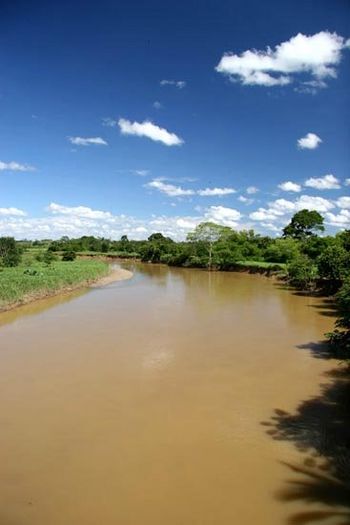San Jorge River facts for kids
Quick facts for kids San Jorge River |
|
|---|---|

San Jorge River in Montelíbano, Córdoba
|
|
| Country | Colombia |
| Physical characteristics | |
| Main source | Paramillo National Park |
| River mouth | Magdalena River |
| Length | 368 km (229 mi) |
| Basin features | |
| Basin size | 96,500 km2 (37,300 sq mi) |
The San Jorge River is an important river in Colombia. It starts in the Paramillo National Park, which is located in the Antioquia and Córdoba areas. The river then flows between the San Geronimo and Ayapel mountains. Finally, it joins the Cauca River in the Sucre Department.
The area that the San Jorge River and its smaller rivers drain is called its drainage basin. This basin covers about 96,500 square kilometres (37,300 sq mi) in southeastern Córdoba. It includes water from the Ayapel swamp and the Mompox region. The river also gets water from its smaller branches, known as tributaries. These include the San Pedro, Dirty, and Ure rivers. The amount of water flowing in the river changes. It can be as low as 24 cubic metres per second (850 cu ft/s) and as high as 697 cubic metres per second (24,600 cu ft/s).
The San Jorge River is home to many fish. However, it has faced problems with pollution. This pollution has harmed the river and its fish.
River History: Discovering the San Jorge
The San Jorge River was first explored by a Spanish explorer named Alonso de Heredia. This happened in the 1530s. He was looking to connect with the native Zenú people. At that time, the river was known by different names, like Xegú or Jegu. Many villages of the ancient Zenú society thrived along its banks. Some of these villages were Yape Zenú, which is now Ayapel, and Tacasuán, which is now San Benito Abad. Heredia later named the river San Jorge. He did this to honor a Christian saint who was famous for fighting a dragon.
Ancient Engineering: The Zenú Canals
In 1966, an American pilot saw something amazing from above. He spotted a huge network of canals and raised areas along the San Jorge River. It looked like the land had been "raked." He realized these were not natural formations. Instead, they were built by people.
Later, in 1986, two Colombian archaeologists, Clemencia Plazas and Anna Maria Falchetti, studied this further. They proved that the Zenú people, an ancient society, built these ridges and canals. These amazing structures cover about 50,000 square kilometres (19,000 sq mi). They are the largest river networks built by ancient people in Hispanic America. This showed that the San Jorge Valley was home to a very advanced society. They found pottery and jewelry, which proved how skilled these people were.
This huge system of canals covers about 20,000 square kilometres (7,700 sq mi). It was built by a group of people who lived in the area between the first and fourth centuries. The San Jorge Valley often floods for several months each year. So, the Zenú people created this drainage system. This allowed them to live there permanently and farm the land.
See also
 In Spanish: Río San Jorge para niños
In Spanish: Río San Jorge para niños

